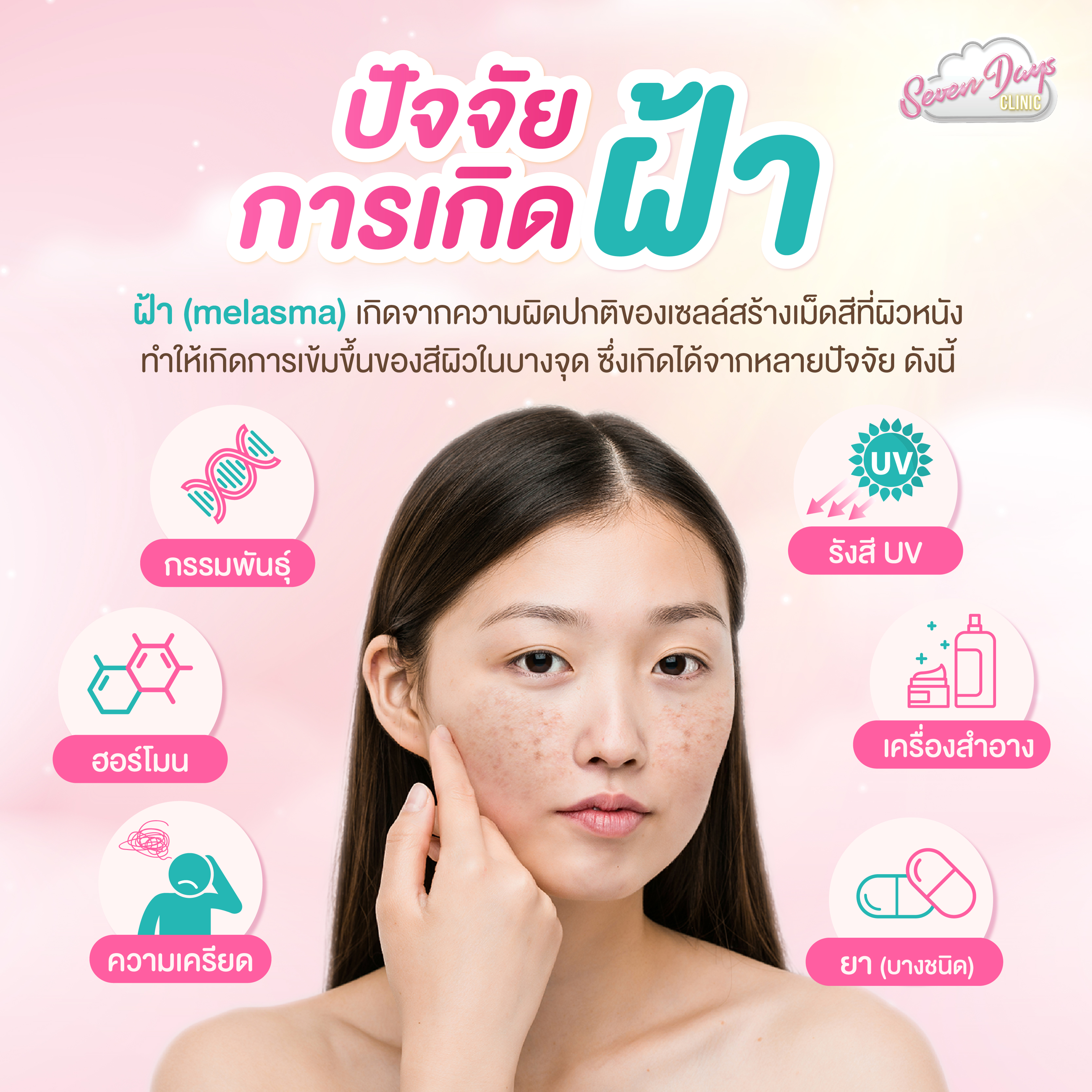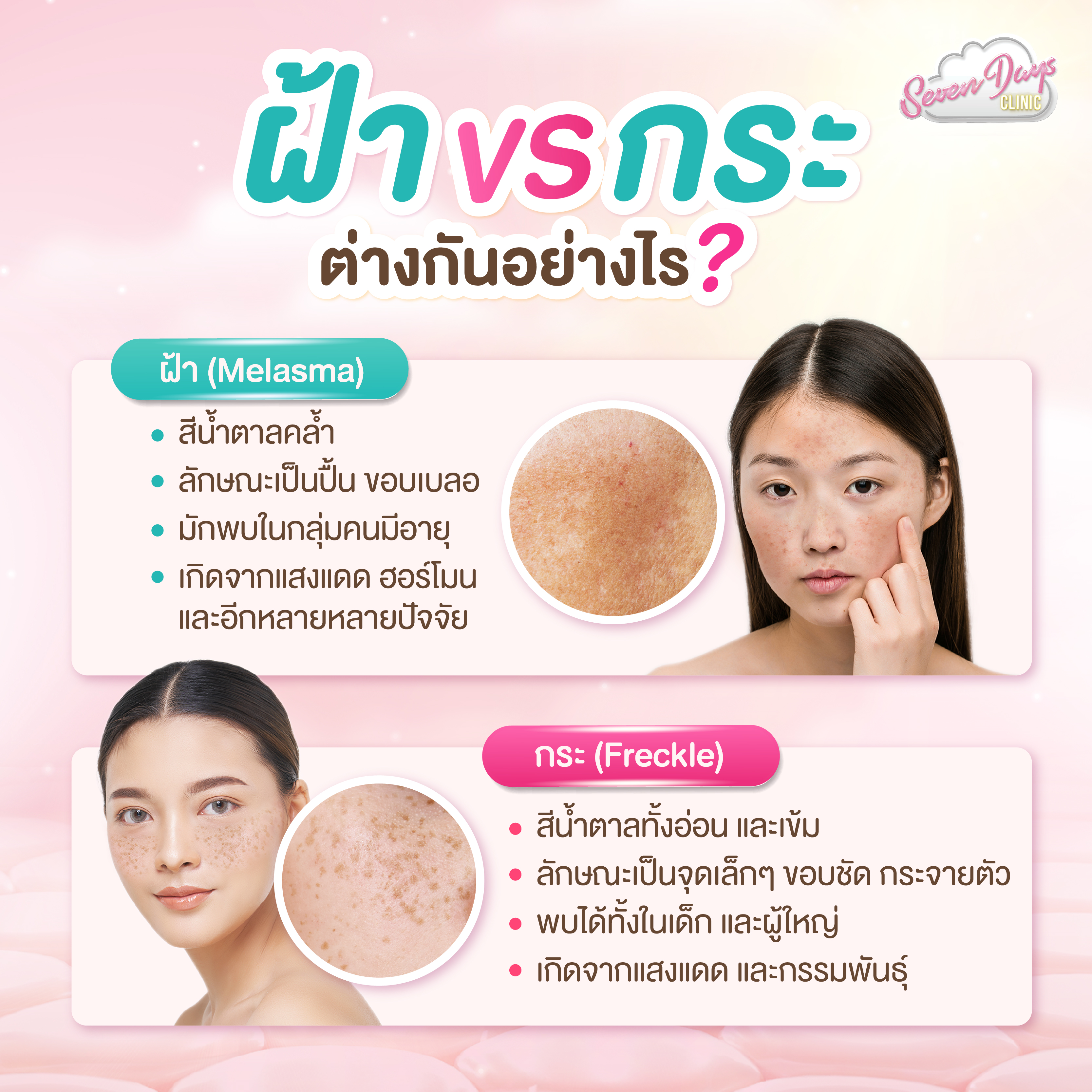ปัจจัยการเกิดฝ้า ?
1228 จำนวนผู้เข้าชม |

รู้ทันการเกิด “ฝ้า (Melasma)”
ฝ้า (Melasma)
หนึ่งในปัญหาผิวที่พบเจอได้ในทุกเพศ ทุกวัย ฝ้าเกิดจากความผิดปกติของเซลล์สร้างเม็ดสีที่ผิวหนัง ทำให้เกิดการเข้มขึ้นของสีผิวในบางจุด มีลักษณะเป็นปื้นสีน้ำตาลหรือดำบนผิว ส่งผลให้ผิวดูไม่เรียบเนียน ฝ้าเกิดได้จากหลากหลายปัจจัย ดังนี้

1. กรรมพันธุ์
การผลิตเม็ดสีที่มากเกินไป จนเป็นสาเหตุที่ทำให้เกิดฝ้า สามารถถ่ายทอดทางกรรมพันธุ์ได้ โดยสามารถส่งต่อกันได้จากคนในครอบครัว มักพบได้ในเพศหญิงมากกว่าเพศชาย และมักพบมากในกลุ่มคนที่มีอายุ 30-40 ปี
2. ฮอร์โมน
ความไม่สมดุลของฮอร์โมนสามารถส่งผลให้การสร้างเม็ดสีของร่างกายที่มีความผิดปกติ จนนำไปสู่ปัญหาฝ้า รวมถึงอาจทำให้เกิดปัญหาสิว หรือที่เรียกกันว่า "สิวฮอร์โมน" อีกด้วย
3. แสงแดดและรังสียูวี
แสงแดดเป็นปัจจัยสำคัญที่ทำให้เกิดฝ้า เพราะในแสงแดดมีรังสี UVA UVB ที่สามารถทำร้ายผิวหนัง ทำให้ผิวหนังหมองคล้ำ กระตุ้นให้เกิดการผลิตเม็ดสีเมลานินมากขึ้น เร่งให้เกิดฝ้า และปัญหาผิวหนังได้หากไม่ป้องกัน
4. เครื่องสำอาง
เครื่องสำอางมักมี สารเคมี สารกันบูด แอลกอฮอล์ หรือสารปรอท ที่จะกระตุ้นทำให้เกิดฝ้าได้ง่าย มักพบได้บ่อยในครีมเร่งหน้าขาวใส หรือครีมผิวขาว ที่เมื่อใช้ในช่วงแรกผิวจะขาวเรียบเนียน แต่พอทานานๆขึ้นผิวจะเริ่มบาง และเกิดอาการแพ้เป็นคนแพ้ง่าย และเกิดจุดด่างดำ หรือฝ้าในที่สุด
5. ความเครียด
เมื่อเราเครียดร่างกายจะสร้างสารอนุมูลอิสระบนชั้นผิวหนังขึ้นมาเป็นจำนวนมาก ซึ่งจะไปกระตุ้นให้ร่างกายผลิตเม็ดสีเมลานินใต้ชั้นผิวหนังเพิ่มมากขึ้นกว่าปกติ จนเกิดเป็นฝ้าได้ในที่สุด
6. ยาบางชนิด
ยาบางประเภท เมื่อทานเข้าไปแล้วอาจกระตุ้นทำให้เกิดฝ้าได้ เนื่องจากตัวยาจะเข้าไปทำปฏิกิริยากับฮอร์โมนในร่างกาย ซึ่งยาจำพวกนี้มีหลายชนิด เช่น ยาคุมกำเนิด ยารักษาอาการทางจิต และยาปฏิชีวนะบางประเภท เป็นต้น

ตำแหน่งจุดเกิดฝ้า
มักจะเกิดได้ในจุดที่โดนแสงแดดบ่อยๆ ทำให้ส่วนมากมักเกิดบริเวณผิวหน้า
โดยเฉพาะบริเวณ
- หน้าผาก
- โหนกแก้ม
- เหนือริมฝีปาก
- จมูก
และมักพบได้น้อยในบริเวณอื่นๆที่โดนแสงแดด เช่น คอ คาง และแขน เป็นต้น
ฝ้า กระ ต่างกันอย่างไร?
แม้ฝ้า และ กระจะมีความคล้ายคลึงกัน แต่ลักษณะของจุดด่างดำของฝ้าและกระมีความแตกต่างกันในหลายจุด ดังนี้

ฝ้า (Melasma)
- มีสีน้ำตาลคล้ำ
- มีลักษณะเป็นปื้น ขอบเบลอ
- มักพบได้บ่อยในกลุ่มคนมีอายุ 30 ปีขึ้น
- มีสาเหตุการเกิดมาจากแสงแดด ฮอร์โมน และอีกหลากหลายปัจจัยทั้งภายใน และภายนอก
กระ (Freckle)
- มีสีน้ำตาลทั้งอ่อน และ เข้ม
- มีลักษณะเป็นจุดด่างดำ หรือรอยด่างดำ มักมีทรงกลมขนาดเล็ก มีขอบที่ชัดเจนไม่เป็นปื้น
- เกิดได้ทั้งในเด็กและผู้ใหญ่
- มีสาเหตุการเกิดมาจากแสงแดด และกรรมพันธุ์
วิธีป้องกันการเกิดฝ้า
แม้ว่า “ฝ้า” นั้นจะไม่มีวิธีรักษาให้หายขาดได้ แต่เราสามารถป้องกัน และหลีกเลี่ยงการเกิดฝ้าได้ ดังนี้

1. หลีกเลี่ยงการโดนแสงแดด
แสงแดดเป็นปัจจัยสำคัญที่ส่งผลให้เกิดฝ้า เพราะในแสงแดดมีทั้งรังสี UVA และ UVB ซึ่งสามารถทำลายผิวได้ ดังนั้นการหลีกเลี่ยงการอยู่ท่ามกลางแสงแดดเป็นเวลานานสามารถช่วยลดโอกาสการเกิดฝ้าได้
2. ทาครีมกันแดดเป็นประจำ
การทาครีมกันแดดสามารถช่วยปกป้องผิวจากการทำร้ายของแสงแดดได้ และยังช่วยป้องกันไม่ให้ผิวสร้างเม็ดสีเมลานินมากขึ้น โดยควรเลือกครีมกันแดดที่มีค่า SPF ค่า PA ที่ได้มาตรฐาน สามารถป้องกันได้ทั้งรังสี UVA และ UVB
3. หลีกเลี่ยงการใช้ยาที่บางชนิด
ตัวยาาบางชนิดอาจส่งผลกระทบต่อฮอร์โมนและทำให้เกิดฝ้ามากขึ้น หรือเข้มกว่าเดิมได้ เช่น ยาคุมกำเนิด
4. เลือกใช้ผลิตภัณฑ์ที่อ่อนโยนต่อผิว
เลือกใช้ครีม หรือเครื่องสำอางที่อ่อนโยน ปราสจากน้ำหอม และแอลกอฮอล์ เพื่อลดการทำร้าย หรือการระคายเคืองผิว
5. ปรึกษาแพทย์ผู้เชี่ยวชาญที่ Seven Days Clinic
การรักษาฝ้าให้ได้ผลลัพธ์ที่ดีที่สุดนั้น ควรรรักษากับแพทย์ผู้เชี่ยวชาญ โดยที่ Seven Days Clinic เรามีทีมแพทย์ผู้เชี่ยวชาญ ที่พร้อมให้คำปรึกษา และรักษาปัญหาฝ้าได้อย่างตรงจุด และเหมาะสมกับผิวของแต่ละบุคคลด้วย
----------------------------------------------------------------------------------------------------------------------------------------------------------------
Understanding Melasma
Melasma is a skin issue that can affect people of all genders and ages. It results from an
abnormality in the cells responsible for pigment production in the skin, leading to darkening of certain areas of the skin. It appears as brown or dark patches on the skin, causing an uneven complexion. Melasma can occur due to various factors, as follows:
1. Genetics:
Overproduction of pigment can be a hereditary trait, which is a leading cause of melasma. It can be passed down through generations, often seen more in females than males, and is more common in the age group of 30-40 years.
2. Hormones:
Hormonal imbalances can affect the body's pigment production, leading to abnormal melanin formation and resulting in melasma. This can also lead to acne problems, known as "hormonal acne."
3. Sunlight and UV Radiation:
Sunlight plays a crucial role in the development of melasma because it contains UVA and UVB radiation, which can harm the skin, darken it, stimulate excess melanin production, and accelerate the occurrence of melasma if not protected.
4. Cosmetics:
Cosmetics often contain chemical ingredients, sunscreens, alcohol, or parabens that can easily trigger melasma. This is frequently found in skin whitening creams or products that initially make the skin appear fair and smooth. However, with prolonged use, the skin may become thin, leading to the development of dark spots or melasma, especially in individuals with sensitive skin.
5. Stress:
When the body is stressed, it produces a significant amount of free radicals on the skin's surface. This can stimulate the body to produce more melanin under the skin layer, leading to melasma.
6. Certain Medications:
Some medications, when ingested, can trigger melasma by interacting with hormones in the body. Such medications come in various types, including birth control pills, psychiatric medications, and some types of antibiotics.
It's essential to understand these causes to help prevent and manage melasma effectively. If you are concerned about melasma or have questions about its treatment, you can contact Seven Days Clinic for more information.
The Location of Melasma Spots
Melasma spots typically occur in areas that are frequently exposed to sunlight. As a result, they most commonly appear on the facial skin, especially in the following areas:
- Cheeks
- Forehead
- Above the upper lip
- Nose
Melasma is less commonly found in other sun-exposed areas, such as the neck, chin, and arms.
How Are Melasma and Freckles Different?
While melasma and freckles share some similarities, they have distinct characteristics that set them apart in several ways. Here are the differences:
Melasma:
- Dark brown in color.
- Appears as blotchy, indistinct patches.
- Commonly found in individuals aged 30 and above.
- Can be caused by factors including sunlight, hormones, and various internal and external
Freckles:
- Light to dark brown in color.
- Manifest as small, round, clearly defined spots.
- Occur in both children and adults.
- Typically caused by sunlight exposure and genetics.
How to Prevent Melasma
Although melasma cannot be completely cured, it is possible to prevent and reduce the likelihood of its occurrence. Here's how:
1. Avoid Sun Exposure:
Sunlight is a significant factor in melasma development, as it contains both UVA and UVB radiation, which can harm the skin. Therefore, minimizing sun exposure for extended periods can reduce the risk of melasma.
2.Apply Sunscreen Regularly:
Using sunscreen helps protect the skin from sun damage and prevents it from producing excess melanin. Choose sunscreen with standardized SPF and PA ratings to provide protection against both UVA and UVB rays.
3.Avoid Certain Medications:
Some medications can impact hormones and lead to the development or darkening of melasma, such as birth control pills.
4.Choose Gentle Skin Products:
Opt for skincare and cosmetics that are gentle and free from fragrances and alcohol to minimize skin irritation.
5.Consult with a Specialist at Seven Days Clinic:
For the best results in treating melasma, it's recommended to seek treatment from a specialized physician. Seven Days Clinic has a team of expert doctors ready to provide tailored advice and suitable solutions for your specific skin needs.
สอบถามข้อมูลเพิ่มเติมได้ที่
For more information, you can reach out through:
Line ID: @sevendaysclinic
Tel: 095-829-6719



